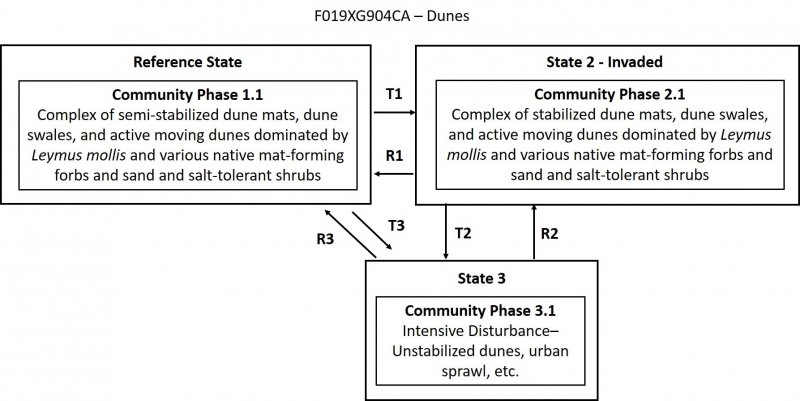Ecological site group R014XG902CA
Beach Ridge
Last updated: 09/07/2023
Accessed: 12/21/2025
Ecological site group description
Key Characteristics
None specified
Provisional. A provisional ecological site description has undergone quality control and quality assurance review. It contains a working state and transition model and enough information to identify the ecological site.
Physiography
This ESG is found on old stabilized and wave cut dunes along the coast and vary from 0 to 50 percent slopes.
Climate
The average annual precipitation in this area is 11 to 53 inches (272 to 1,353 millimeters). The higher amounts of precipitation occur at the higher elevations in the area north of San Francisco. Most of the rainfall occurs as low- or moderate-intensity, Pacific frontal storms during winter. This area is very dry from midspring to midautumn. Snowfall is rare. The average annual temperature is 54 to 61 degrees F (12 to 16 degrees C). The freeze-free period averages 315 days and ranges from 265 to 365 days. It is longest near the coast, and it becomes shorter with elevation.
Soil features
This ESG covers areas along the coast that are old relic sand dunes that are deep, somewhat excessively drained soils.
Baywood, a sandy, mixed, thermic Entic Haploxeroll
Sirdrak, a sandy, mixed, isomesic Humic Dystrustept
Vegetation dynamics
Beach ridges are cut off and stabilized dunes that are older directly adjacent to the beaches. They consist of only small areas of actively moving sand to well vegetated dune ridges. Many of the older, more stabilized dunes covered in coastal scrub or non-native annual grasses and forbs.
Abiotic Factors/Primary Disturbances
Salt spray, soil salinity, sea-water immersion and sand movement are the most critical abiotic factors for this ecological site concept, primarily in the context of geologic processes and coastline water and wind currents. The salt spray gradient is a function of wind speed, distance from the tide line, height above the ground, and microtopography. Hypertrophy (succulence) accounts for the ability of dicots to withstand salt spray, and grasses that lack this ability, rely on a thick cuticle instead. Salt spray tolerance dictates the species composition that dominates the different areas of this ecological site, but also impacts the structure of the vegetation expression as well. Although beach species are not obligate halophytes, they are tolerant of soil salinity and occasional seawater immersion. Germination and establishment phases of most beach species is when they are the most vulnerable to the soil salinity, and therefore depend on times that seawater immersion and impacts from salt water are minimal until after full establishment.
Water deposition, onshore winds, dessication, nutrient limitations, and sand burial are the most important disturbances that naturally drive the dynamics of this ecological site concept. Adaptations to sand burial are key adaptations for vegetation in this ecological site, developing larger, heavier seeds that have the ability to emerge from much greater depths once germinated. These species have also adapted to planting themselves deeper in the sands to take advantage of higher soil moisture content and protection from the wind/sea salt spray.
Dessication is a major stressor to this ESG, namely from intense solar radiation and evapotranspiration, seasonal drought, and low water-holding capacities of the sands typical of this ecological site. The species that dominate this ecological site are adapted to these conditions, using various rooting strategies, leaf morphologies that can withstand high levels of solar radiation, high light intensities for photosynthesis, and wind dessication, and root and shoot strategies to ameliorate the low-fertility soil conditions.
Major Land Resource Area
MLRA 014X
Central California Coastal Valleys
Stage
Provisional
Click on box and path labels to scroll to the respective text.
